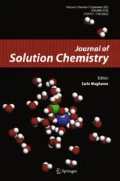Abstract
Absorption spectra of eight 3-substituted-5,5-diphenylhydantoins have been recorded in fourteen solvents in the range 200–400 nm. The effect of solvent dipolarity/polarizability and solvent/solute hydrogen bonding interactions are analyzed by means of the linear solvation energy relationship (LSER) concept proposed by Kamlet and Taft. The lipophilic activity of the investigated hydantoins was estimated by the calculation of log 10 P values with the Advanced Chemistry Development Software. The calculated values of log 10 P were correlated with the ratio of the contributions of specific solvent interactions, and, by employing the linear dependence thus obtained, the pharmacological activity of the studied hydantoin derivatives is discussed.
Similar content being viewed by others
References
Lopez, A.C., Trigo, C.G.: In: Katrizky, A.R. (ed.) The Chemistry of Hydantoins. Advances in Heterocyclic Chemistry. Academic Press, New York (1985)
Scholl, S., Koch, A., Henning, D., Kempter, G., Kleinpeter, E.: The influence of structure and lipophilicity of hydantoin derivatives on anticonvulsant activity. Struct. Chem. 10, 355–366 (1999)
Knabe, J., Baldauf, J., Ahlhem, A.: Racemates and enantiomers of basic substituted 5-phenylhydantoins. Syntheses and antiarrhythmic activity. Pharmazie 52, 912–919 (1997)
Anger, T., Madge, D.J., Mulla, M., Riddall, D.: Medicinal chemistry of neuronal voltage-gated sodium channel blockers. J. Med. Chem. 44, 115–137 (2001)
Kleinpeter, E.: The structure of hydantoins in solution and in the solid state. Struct. Chem. 8, 161–173 (1997)
Rodgers, T.R., LaMontagne, M.P., Markovac, A., Ach, A.B.: Hydantoins as antitumor agents. J. Med. Chem. 20, 591–594 (1977)
Meldrum, B.S.: Identification and preclinical testing of novel antiepileptic compounds. Epilepsia 38, S7–S15 (1997)
Seydel, J.K., Schaper, K.J.: In: Schemische Struktur und Biologische Wirkung von Wirkstoffen, Metoden der Quantitativen Structur–Wirkungsanalyse. Verlag Chemie, Weinheim (1979)
Hacksell, U.: In: Krogsgaard-Larsen, P., Madsen, U. (eds.) A Textbook of Drug Design and Development. Harwood Academic Publishers, Amsterdam (1996)
Brouillette, W.J., Brown, G.B., DeLorey, T.M., Liang, G.: Sodium channel binding and anticonvulsant activities of hydantoin containing conformationally constrained 5-phenyl substituents. J. Pharm. Sci. 79, 871–874 (1990)
Brouillette, W.J., Jestkov, V.P., Brown, M.L., Akhtar, M.S., DeLorey, T.M., Brown, G.B.: Bicyclic hydantoins with a bridgehead nitrogen. Comparison of anticonvulsant activities with binding to the neuronal voltage-dependent sodium channel. J. Med. Chem. 37, 3289–3293 (1994)
Unverferth, K., Engel, J., Höfgen, N., Rostock, A., Günther, R., Lankau, H.J., Menzer, M., Rolfs, A., Liebscher, J., Müller, B., Hofmann, H.J.: Synthesis. anticonvulsant activity, and structure-activity relationships of sodium channel blocking 3-aminopyrroles. J. Med. Chem. 41, 63–73 (1998)
Poupaert, J.H., Vandervarst, D., Guiot, P., Moustafa, M.M.M., Dumont, P.: Structure–activity relationship of phenytoin-like anticonvulsant drugs. J. Med. Chem. 27, 76–78 (1984)
Jones, G.L., Woodbury, D.M.: Anticonvulsant structure–activity relationships: historical development and probable causes of failure. Drug Dev. Res. 2, 333–355 (1982)
Kamlet, M.J., Abboud, J.L.M., Taft, R.W.: An examination of linear solvation energy relationships. Prog. Phys. Org. Chem. 13, 485–630 (1981)
Abboud, J.L.M., Kamlet, M.J., Taft, R.W.: Regarding a generalized scale of solvent polarities. J. Am. Chem. Soc. 99, 8325–8327 (1977)
Kamlet, M.J., Taft, R.W.: The solvatochromic comparison method. I. The β-scale of solvent hydrogen-bond acceptor (HBA) basicities. J. Am. Chem. Soc. 98, 377–383 (1976)
Kamlet, M.J., Taft, R.W.: Linear solvation energy relationships. Part 3. Some reinterpretations of solvent effects based on correlations with solvent π * and α values. J. Chem. Soc. Perkin Trans. 2, 349–356 (1979)
Kamlet, M.J., Doherty, R.M., Abboud, J.L.M., Abraham, M.H., Taft, R.W.: Solubility: a new look. Chemtech 16, 566–576 (1986)
Carr, P.W., Doherty, R.M., Kamlet, M.J., Taft, R.W., Melander, W., Horvath, C.: Study of temperature and mobile-phase effects in reversed-phase high–performance liquid chromatography by the use of the solvatochromic comparison method. Anal. Chem. 58, 2674–2680 (1986)
Ušćumlić, G.S., Mijin, D.Ž., Valentić, N.V., Vajs, V., Sušić, B.: Substituent and solvent effects on the UV/Vis absorption spectra of 5-(4-substituted arylazo)-6-hydroxy-4-methyl-3-cyano-2-pyridones. Chem. Phys. Lett. 397, 148–153 (2004)
Mijin, D.Ž., Ušćumlić, G.S., Perišić-Janjić, N.U., Valentić, N.V.: Substituent and solvent effects on the UV/vis absorption spectra of 5-(3- and 4-substituted arylazo)-4,6-dimethyl-3-cyano-2-pyridones. Chem. Phys. Lett. 418, 223–229 (2006)
Magnes, B.Z., Pines, D., Strashnikova, N., Pines, E.: Hydrogen-bonding interactions of photoacids: Correlation of optical solvatochromism with IR absorption spectra. Solid State Ionics 168, 225–233 (2004)
Spange, S., Kunzmann, D., Sens, R., Roth, I., Seitfert, A., Thiel, W.R.: Solvatochromic azamethine dyes for probing the polarity of gold-cluster-functionalized silica particles. Chem. Eur. J. 9, 4161–4167 (2003)
Vida, J.A., Samour, C.M., Reinhard, J.F.: Anticonvulsants. 1. Alkoxymethyl derivatives of barbiturates and diphenylhydantoin. J. Med. Chem. 14, 187–189 (1971)
Mai, K.H.X., Patil, G.: Preparation of 2-(1-hydroxyalkyl)-5,5-diphenylhydantoins as drug intermediates. U.S. Patent 4,709,042 (1987); Chem. Abstr. 108, 94560 (1987)
Vida, J.A., Wilber, W.R., Reinhard, J.F.: Anticonvulsants. 2. Acyloxymethyl and halomethyl derivatives of barbituric acid and diphenylhydantoin. J. Med. Chem. 14, 190–193 (1971)
Hoffmann, C.: Synthesis of some 3-substituted 5,5-diphenylhydantoins. Bull. Soc. Chim. Fr., 45–47 (1950)
Muccioli, G.G., Wouters, J., Poupaert, J.H., Norberg, B., Poppitz, W., Scriba, E.K.G., Lambert, D.M.: Versatile access to benzhydryl-phenylureas through an unexpected rearrangement during microwave-enhanced synthesis of hydantoins. Org. Lett. 5, 3599–3602 (2003)
Kamlet, M.J., Abboud, J.L.M., Abraham, M.H., Taft, R.W.: Linear solvation energy relationships. 23. A comprehensive collection of the solvatochromic parameters, π *, α, and β, and some methods for simplifying the generalized solvatochromic equation. J. Org. Chem. 48, 2877–2887 (1983)
Taft, R.W., Abboud, J.-L.M., Kamlet, M.J.: Solvatochromic comparison method. 20. Linear solvation energy relationships. 12. The dδ term in the solvatochromic equations. J. Am. Chem. Soc. 103, 1080–1086 (1981)
Ušćumlić, G.S., Kshad, A.A., Mijin, D.Ž.: Synthesis and investigation of solvent effects on the ultraviolet absorption spectra of 1,3-bis-substituted-5,5-dimethylhydantoins. J. Serb. Chem. Soc. 68, 699–706 (2003)
Ware, E.: The chemistry of the hydantoins. Chem. Rev. 46, 403–70 (1950)
Vida, J.A., O’Dea, M.H., Samour, C.M., Reinhard, J.F.: Anticonvulsants. 5. Derivatives of 5-ethyl-5-phenylhydantoin and 5,5-diphenylhydantoin. J. Med. Chem. 18, 383–385 (1975)
Author information
Authors and Affiliations
Corresponding author
Rights and permissions
About this article
Cite this article
Banjac, N., Ušćumlić, G., Valentić, N. et al. Solvent Effects on the Structure-Activity Relationship of Pharmacological Active 3-Substituted-5,5-Diphenylhydantoins. J Solution Chem 36, 869–878 (2007). https://doi.org/10.1007/s10953-007-9153-2
Received:
Accepted:
Published:
Issue Date:
DOI: https://doi.org/10.1007/s10953-007-9153-2




